
views
- Apply household cleaners like a baking soda paste, toothpaste, or diluted vinegar to scorched, sticky, or dirty areas of the soleplate and wipe them clean.
- To clean the reservoir, fill it ⅓ of the way full with a diluted vinegar mixture and expel the mixture with the steam setting.
- To clean out the steam holes, dip cotton swabs in distilled white vinegar and scrub inside the holes.
Baking soda paste
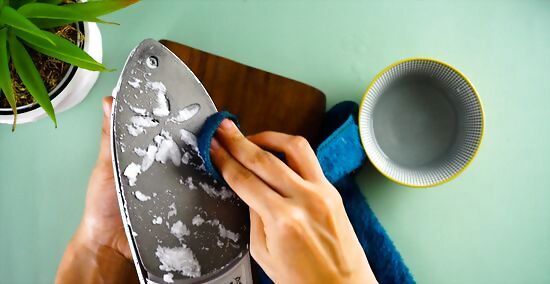
Apply a baking soda paste to deposits on the soleplate to clear them up. First, combine 1 tbsp (15 mL) of distilled water and 2 tbsp (34 g) of baking soda in a small bowl to form a thick paste that will stick to the iron. With the iron off and cool, spread the paste onto areas with residue or deposits (or the entire soleplate for a general cleaning). Let the paste sit for a few minutes, then wipe it away with a clean, damp cloth. If any baking soda makes its way into the steam holes, use a cotton swab dipped in distilled water or white vinegar to clear the blockage. Baking soda is lightly abrasive and can be used to clean a number of surfaces around the house.
White vinegar (for soleplate)
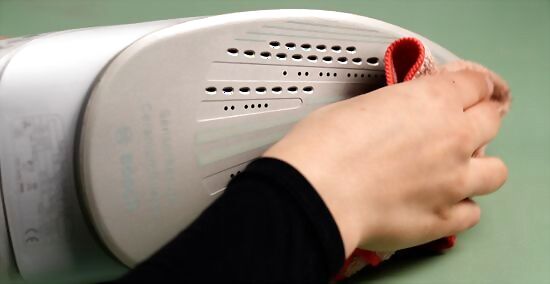
Wipe the soleplate with a cloth soaked in diluted white vinegar. First, unplug your iron and allow it to cool fully. Then, make a solution of equal parts distilled water and white vinegar. Dip a microfiber cloth into the solution and use it to rub the soleplate gently, paying extra attention to especially scorched, sticky, or dirty areas. Once the soleplate is clean, wipe away any remaining vinegar with a damp, clean cloth. Alternatively, use a solution of equal parts white vinegar and salt for extra scorched iron plates. Heat up the mixture in a pan to help the salt dissolve, and wait for it to cool before applying it to your iron. Or, to avoid scrubbing, soak the cloth in the vinegar-water mixture and wrap it around the base of the iron for 30 minutes. Then, remove the cloth and wipe the soleplate dry.
White vinegar (for reservoir)

Use diluted vinegar to clean the reservoir and clear the steam holes. Pour out any old water from the reservoir, then fill it about ⅓ of the way full with a mixture of 3 parts water and 1 part distilled white vinegar. Turn the iron on to its hottest setting and wait a few minutes for it to heat up. Then, steam-iron an old towel or cloth for several minutes. The hot vinegar mixture will break up any deposits in the steam holes or reservoir and expel them. Use a towel or cloth that you don’t mind getting a bit dirty. If there are significant deposits in the steam holes, the iron may leave streaks or residue on the fabric. If you have a manual steam button, press the button often to help release even more steam. When you’re finished, pour any remaining vinegar mixture out of the reservoir and wait for the iron to cool before storing it. Read your iron’s instruction manual to make sure that it will tolerate vinegar before trying this method.
Cotton swabs
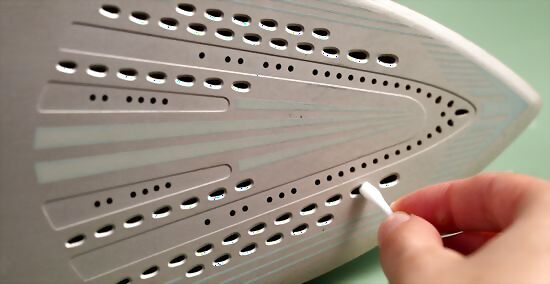
Use vinegar-soaked cotton swabs to clear out clogged steam holes. If you notice your iron isn’t steaming like it used to, there may be mineral deposits in the steam vents or holes. Simply dip the end of a cotton ear swab into distilled white vinegar and scrub inside the hole until the deposits dissolve away (it may take a few minutes of scrubbing for the vinegar to saturate and break up the deposit if it’s extra thick or stubborn).
Dryer sheets

Rub dryer sheets on the warm soleplate to remove residue. Plug in your iron and set it to the lowest heat setting available, then let it warm up for a few minutes. Grab several fresh dryer sheets and rub the soleplate with them like you’re using a sponge. Keep rubbing gently until all of the dirt and gunk are gone. Afterward, turn your iron to the highest setting and iron over an old towel to remove any fibers or residue from the dryer sheets. To protect your fingers, wear heat-resistant gloves or change dryer sheets when you feel your fingertips getting hot.
Toothpaste
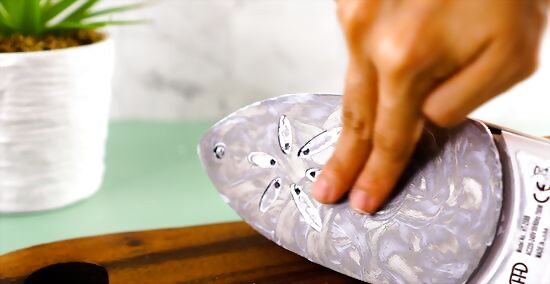
Dab toothpaste on residue spots on the soleplate and wipe them away. With your iron off and cool, smear a bit of toothpaste directly onto brown, sticky, or dirty spots and leave it to sit for about a minute. Then, use a clean cloth to wipe the toothpaste away. Fill up the reservoir with fresh water, set the iron to steam, and lay it down on an old towel or cloth for 5 minutes to finish the job. Alternatively, try a mixture of 1 tbsp (3 g) of toothpaste, 2 tbsp (6 g) of baking soda, and 3 tbsp (45 mL) of vinegar.
Newspaper or parchment paper
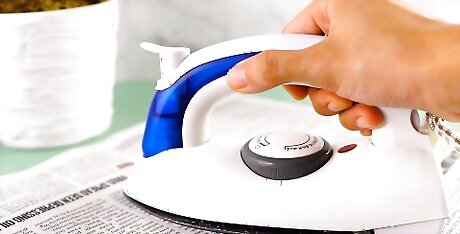
Iron over newspaper and salt to clean up a sticky iron. If you notice your iron sticking while using it, sprinkle a generous amount of salt over a sheet of newspaper or something waxy like parchment paper. Set your iron to warm, let it heat up for a few minutes, and then iron over the salt in all directions until it’s clean. Once the stickiness is gone, shake off the excess salt to reveal a clean soleplate. Use a damp cotton swab to wipe away any salt that’s stuck in the steam holes.
Ice cubes
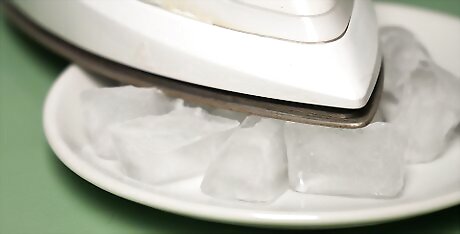
Harden melted plastic residue with ice, then scrape it away. Fill a shallow bowl, dish, or sauce pan with ice cubes, then place the iron plate-down into the ice to freeze and harden melted-on plastic (it’ll take about 10 minutes if the plastic is fresh). Once the plastic is fully hardened, use a blunt plastic knife to scrape the plastic spot away from the soleplate. Do not use a metal knife or other metal object on the bottom of your iron, as this can scratch or damage it.
Aluminum foil
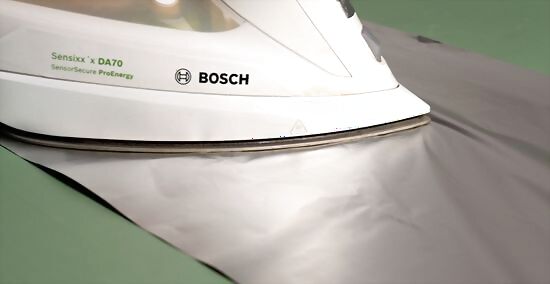
Iron over a sheet of aluminum foil to remove hard water stains. Lay a large sheet of foil over your ironing board and let your iron heat up to a hot setting. Then, just iron over the foil until the mineral deposits from hard water disappear from the soleplate. The metals used in aluminum foil will separate the minerals from your iron, leaving it looking good as new.
Acetaminophen
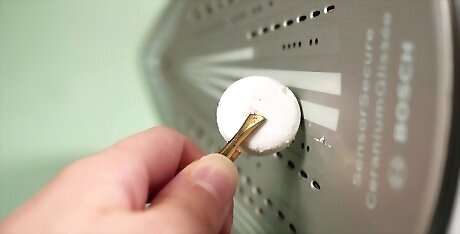
Rub acetaminophen (Tylenol) tablets over rusted, dirty spots. Turn your iron to a hot setting and wait for it to heat up. Then, grab an acetaminophen tablet with a pair of tweezers and press and rub it into rusty or dirty spots. As the tablet dissolves, it will break up residue and clear it away. When the spot is gone, wipe the plate clean with a soft cloth. If the tablet dissolves before the dirty spot is gone, just grab another pill with your tweezers and keep rubbing.
Magic Eraser or scouring pad
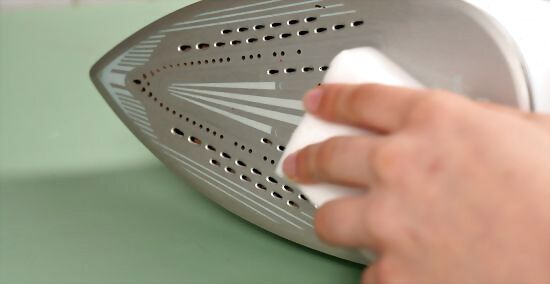
Use scrubbing pads to remove sticky residue or scorch marks. Soak your scrubbing pad of choice in water, then squeeze out the excess. Using firm pressure, rub down the soleplate of the iron, giving extra strokes and scrubs to especially sticky, scorched, or dirty areas. If needed, wipe the plate dry with a clean, soft cloth once the marks are gone. A soft pad like a Magic Eraser will be less harsh on your iron than something like a Brillo Pad or steel wool scourer, which could potentially scratch the soleplate if you use too much pressure. However, a more abrasive steel wool or Brillo Pad may be more effective for sticky spots left behind from ironing over adhesives.
Commercial iron cleaner

Use an iron-cleaning paste made specifically to clean soleplates. Commercial iron cleaners can be found at most stores in the laundry or fabric cleaning aisles. Follow the directions of your product specifically—in most cases, you’ll apply the paste to a hot soleplate and wipe it away, or apply the paste to an old towel and iron over it. Either way, the paste will dissolve and remove residue to leave your soleplate like new. Or, try using a disposable iron cleaning cloth. Just wipe down your hot soleplate or iron over the cloth for mild residue or regular maintenance cleaning.




















Comments
0 comment